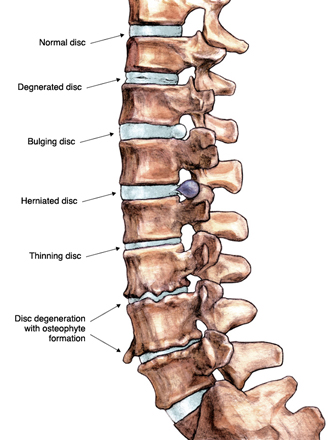Degenerative disc disease is not a “disease” rather, it is a term used to describe changes to the spinal discs caused by aging or excessive wear and tear. This condition can occur anywhere along the spinal column but most commonly affects the lower back.
When discs deteriorate, their ability to absorb shock and cushion the spine is compromised. Because discs have a unique biology and limited blood supply, the disc cannot repair itself once an injury occurs.

Degenerative disc disease causes discs to dry out, lose height, and become stiff. When disc height is lost, nerve impingement, adjacent bone and joint inflammation, and varying degrees of pain can occur. Should the disc become torn or damaged, the jelly-like material in the center can leak onto nearby nerves, causing inflammation and pain. Microscopic tears in the disc can also irritate the nerves in the annulus (the thick fibrous ring surrounding the disc).
Causes
Factors that contribute to the development of degenerative disc disease include:
- Age – discs lose water with age, reducing the distance between the vertebrae. This collapse of the cushioning between spinal bones places stress on the annulus.
- Injury – acute or repetitive stress to the spine can damage the disc
Symptoms
- Dull ache to severe, incapacitating pain
- Location of pain is dependent upon the region of the spine affected
- Pain is relieved by lying down (for some patients)
- Numbness, tingling, or weakness in the extremities
Treatment
Conservative treatment for degenerative disc disease consisting of bed rest or restricted activity may be prescribed for mild pain. Anti-inflammatory medications, physical therapy, and/or epidural steroid injections are often recommended to treat short-term moderate pain. Should your condition cause considerable distress or disability, Dr. Stieber can explain the various surgical solutions that may be appropriate for your condition. Diagnostic tests may include a CT scan, MRI, myelogram, or discography.
Common Procedures
- Minimally invasive interbody fusion (fusing the vertebrae above and below the disc space)
- Artificial disc replacement
- Discectomy to remove an intervertebral disc, or portions thereof
- Laminotomy to make more space and relieve pressure on nerve roots
Although there is no guarantee that surgery will help in every case, the majority of patients suffering from symptoms of degenerative disc disease can obtain relief from surgical intervention.
If you are seeking treatment for degenerative disc disease, please reach out to us here.
